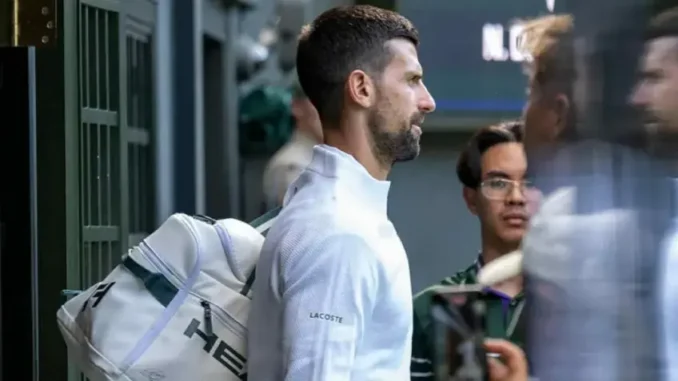
In the high-stakes world of professional tennis, few players have defined resilience like Novak Djokovic. The Serbian legend, with 24 Grand Slam titles and a record 428 weeks as world No. 1, has long been a titan of the sport. Yet, at 38, his body is showing signs of wear, and his recent injury-plagued performances, particularly at the 2025 Wimbledon Championships, have sparked intense discussion. Former ATP star John Isner, a towering figure known for his record-breaking serve, recently weighed in on Djokovic’s struggles, offering a candid perspective on the physical toll of chasing greatness against a new generation of stars like Jannik Sinner and Carlos Alcaraz.
Djokovic’s 2025 season has been a rollercoaster, marked by his relentless pursuit of a 25th major title and a historic 100th ATP title. However, injuries have cast a shadow over his ambitions. A right knee injury forced him to withdraw from the French Open quarterfinals, requiring meniscus surgery, while a muscle issue hampered his performance at Wimbledon, where he was outclassed by Sinner in the semifinals. “I’ve had a bit more injuries lately than I did in the first 15 years of my career,” Djokovic admitted in an interview earlier this year. “This probably comes with age, but my body still listens to me, I still have a burning desire.” His determination to compete, despite these setbacks, underscores the fierce competitiveness that has defined his career, but it also raises questions about how much longer he can defy time.
Isner, who retired in 2023 after a 17-year career, including a peak ranking of world No. 8 and the ATP record for career aces (13,990), offered insight into Djokovic’s challenges during a recent episode of the *Nothing Major* podcast. Having faced Djokovic 12 times, with a 2-10 head-to-head record, Isner knows the Serbian’s game intimately. Reflecting on Djokovic’s Wimbledon loss to Sinner, Isner noted that the defeat wasn’t due to fatigue or overuse but rather a specific incident. “This was a result of a slip; this was not him coming in tired and haggard and too many miles on his body throughout the course of the tournament,” Isner said. He speculated that Centre Court’s surface might be a factor, adding, “It seems to me that Centre Court, and maybe I’m completely wrong, but it is a bit more slippery than any of the other courts because Jannik Sinner, when he did his elbow, was on Centre.” Sinner’s own elbow injury during the tournament, which required an MRI, lent credence to Isner’s observation about the court’s unique challenges.
Djokovic’s physical struggles are a stark contrast to his earlier years, when he enjoyed a relatively injury-free career. A notable elbow injury in 2017 sidelined him until his triumphant 2018 Wimbledon comeback, but recent years have seen a string of setbacks. “There’s no longer any muscle tear,” Djokovic said ahead of the Qatar Open in February 2025, signaling his recovery from the French Open injury. “The injury is almost 100 per cent healed and I’m ready to go for more victories.” Yet, his Wimbledon performance suggested otherwise, as he struggled to match Sinner’s pace and power. The Italian, now a four-time Grand Slam champion, dominated the semifinal 6-4, 6-4, 6-3, ending Djokovic’s hopes of becoming the oldest Wimbledon champion in history.
Isner’s commentary also highlighted the broader challenge Djokovic faces: competing against younger, hungrier players like Sinner and Alcaraz, who have claimed seven of the last eight majors. “At this point, it is legitimate to wonder whether or not Novak will have another chance to become the oldest ever to lift a Major title,” Isner mused, acknowledging the daunting task of overcoming these rising stars. Alcaraz, the two-time defending Wimbledon champion, and Sinner, the world No. 1, represent a generational shift, their speed and power testing even Djokovic’s legendary fitness and court coverage.
Despite these hurdles, Djokovic remains undeterred, with his sights set on the U.S. Open in August 2025. His ability to return serve, ranked among the best in ATP history, and his improved first serve—praised by Isner as a “major weapon” since working with coach Goran Ivanisevic—keep him competitive. “Novak has greatly improved his serve over the years,” Isner noted in a 2021 interview. “For someone who plays a lot of grueling exchanges like Djokovic, getting a few points for free is a breath of fresh air.” This evolution has helped Djokovic stay in the fight, even as injuries mount.
For Isner, who once pushed Djokovic to the brink in a five-set thriller at the 2010 Davis Cup, the Serbian’s resilience is a testament to his greatness. But the physical toll is undeniable, and the tennis world watches with bated breath to see if Djokovic can reclaim his dominance. As he prepares for New York, his “burning desire” fuels his pursuit, but the question lingers: can his body keep pace with his ambition? For now, fans and former rivals like Isner can only marvel at his tenacity, even as the sport’s new guard pushes him to his limits.
Leave a Reply